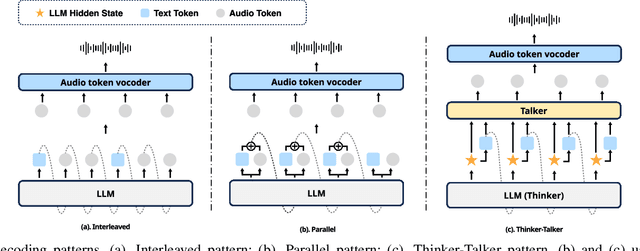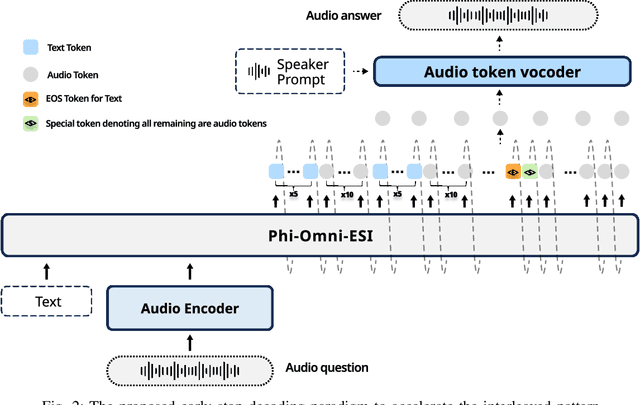Xiaofei Wang
SHANKS: Simultaneous Hearing and Thinking for Spoken Language Models
Oct 08, 2025



Abstract:Current large language models (LLMs) and spoken language models (SLMs) begin thinking and taking actions only after the user has finished their turn. This prevents the model from interacting during the user's turn and can lead to high response latency while it waits to think. Consequently, thinking after receiving the full input is not suitable for speech-to-speech interaction, where real-time, low-latency exchange is important. We address this by noting that humans naturally "think while listening." In this paper, we propose SHANKS, a general inference framework that enables SLMs to generate unspoken chain-of-thought reasoning while listening to the user input. SHANKS streams the input speech in fixed-duration chunks and, as soon as a chunk is received, generates unspoken reasoning based on all previous speech and reasoning, while the user continues speaking. SHANKS uses this unspoken reasoning to decide whether to interrupt the user and to make tool calls to complete the task. We demonstrate that SHANKS enhances real-time user-SLM interaction in two scenarios: (1) when the user is presenting a step-by-step solution to a math problem, SHANKS can listen, reason, and interrupt when the user makes a mistake, achieving 37.1% higher interruption accuracy than a baseline that interrupts without thinking; and (2) in a tool-augmented dialogue, SHANKS can complete 56.9% of the tool calls before the user finishes their turn. Overall, SHANKS moves toward models that keep thinking throughout the conversation, not only after a turn ends. Animated illustrations of Shanks can be found at https://d223302.github.io/SHANKS/
Improving Practical Aspects of End-to-End Multi-Talker Speech Recognition for Online and Offline Scenarios
Jun 17, 2025Abstract:We extend the frameworks of Serialized Output Training (SOT) to address practical needs of both streaming and offline automatic speech recognition (ASR) applications. Our approach focuses on balancing latency and accuracy, catering to real-time captioning and summarization requirements. We propose several key improvements: (1) Leveraging Continuous Speech Separation (CSS) single-channel front-end with end-to-end (E2E) systems for highly overlapping scenarios, challenging the conventional wisdom of E2E versus cascaded setups. The CSS framework improves the accuracy of the ASR system by separating overlapped speech from multiple speakers. (2) Implementing dual models -- Conformer Transducer for streaming and Sequence-to-Sequence for offline -- or alternatively, a two-pass model based on cascaded encoders. (3) Exploring segment-based SOT (segSOT) which is better suited for offline scenarios while also enhancing readability of multi-talker transcriptions.
MetaEformer: Unveiling and Leveraging Meta-patterns for Complex and Dynamic Systems Load Forecasting
Jun 15, 2025Abstract:Time series forecasting is a critical and practical problem in many real-world applications, especially for industrial scenarios, where load forecasting underpins the intelligent operation of modern systems like clouds, power grids and traffic networks.However, the inherent complexity and dynamics of these systems present significant challenges. Despite advances in methods such as pattern recognition and anti-non-stationarity have led to performance gains, current methods fail to consistently ensure effectiveness across various system scenarios due to the intertwined issues of complex patterns, concept-drift, and few-shot problems. To address these challenges simultaneously, we introduce a novel scheme centered on fundamental waveform, a.k.a., meta-pattern. Specifically, we develop a unique Meta-pattern Pooling mechanism to purify and maintain meta-patterns, capturing the nuanced nature of system loads. Complementing this, the proposed Echo mechanism adaptively leverages the meta-patterns, enabling a flexible and precise pattern reconstruction. Our Meta-pattern Echo transformer (MetaEformer) seamlessly incorporates these mechanisms with the transformer-based predictor, offering end-to-end efficiency and interpretability of core processes. Demonstrating superior performance across eight benchmarks under three system scenarios, MetaEformer marks a significant advantage in accuracy, with a 37% relative improvement on fifteen state-of-the-art baselines.
Audio-Aware Large Language Models as Judges for Speaking Styles
Jun 06, 2025Abstract:Audio-aware large language models (ALLMs) can understand the textual and non-textual information in the audio input. In this paper, we explore using ALLMs as an automatic judge to assess the speaking styles of speeches. We use ALLM judges to evaluate the speeches generated by SLMs on two tasks: voice style instruction following and role-playing. The speaking style we consider includes emotion, volume, speaking pace, word emphasis, pitch control, and non-verbal elements. We use four spoken language models (SLMs) to complete the two tasks and use humans and ALLMs to judge the SLMs' responses. We compare two ALLM judges, GPT-4o-audio and Gemini-2.5-pro, with human evaluation results and show that the agreement between Gemini and human judges is comparable to the agreement between human evaluators. These promising results show that ALLMs can be used as a judge to evaluate SLMs. Our results also reveal that current SLMs, even GPT-4o-audio, still have room for improvement in controlling the speaking style and generating natural dialogues.
Towards Autonomous In-situ Soil Sampling and Mapping in Large-Scale Agricultural Environments
Jun 06, 2025Abstract:Traditional soil sampling and analysis methods are labor-intensive, time-consuming, and limited in spatial resolution, making them unsuitable for large-scale precision agriculture. To address these limitations, we present a robotic solution for real-time sampling, analysis and mapping of key soil properties. Our system consists of two main sub-systems: a Sample Acquisition System (SAS) for precise, automated in-field soil sampling; and a Sample Analysis Lab (Lab) for real-time soil property analysis. The system's performance was validated through extensive field trials at a large-scale Australian farm. Experimental results show that the SAS can consistently acquire soil samples with a mass of 50g at a depth of 200mm, while the Lab can process each sample within 10 minutes to accurately measure pH and macronutrients. These results demonstrate the potential of the system to provide farmers with timely, data-driven insights for more efficient and sustainable soil management and fertilizer application.
Towards Efficient Speech-Text Jointly Decoding within One Speech Language Model
Jun 04, 2025



Abstract:Speech language models (Speech LMs) enable end-to-end speech-text modelling within a single model, offering a promising direction for spoken dialogue systems. The choice of speech-text jointly decoding paradigm plays a critical role in performance, efficiency, and alignment quality. In this work, we systematically compare representative joint speech-text decoding strategies-including the interleaved, and parallel generation paradigms-under a controlled experimental setup using the same base language model, speech tokenizer and training data. Our results show that the interleaved approach achieves the best alignment. However it suffers from slow inference due to long token sequence length. To address this, we propose a novel early-stop interleaved (ESI) pattern that not only significantly accelerates decoding but also yields slightly better performance. Additionally, we curate high-quality question answering (QA) datasets to further improve speech QA performance.
Phi-Omni-ST: A multimodal language model for direct speech-to-speech translation
Jun 04, 2025Abstract:Speech-aware language models (LMs) have demonstrated capabilities in understanding spoken language while generating text-based responses. However, enabling them to produce speech output efficiently and effectively remains a challenge. In this paper, we present Phi-Omni-ST, a multimodal LM for direct speech-to-speech translation (ST), built on the open-source Phi-4 MM model. Phi-Omni-ST extends its predecessor by generating translated speech using an audio transformer head that predicts audio tokens with a delay relative to text tokens, followed by a streaming vocoder for waveform synthesis. Our experimental results on the CVSS-C dataset demonstrate Phi-Omni-ST's superior performance, significantly surpassing existing baseline models trained on the same dataset. Furthermore, when we scale up the training data and the model size, Phi-Omni-ST reaches on-par performance with the current SOTA model.
Sentinel: Scheduling Live Streams with Proactive Anomaly Detection in Crowdsourced Cloud-Edge Platforms
May 29, 2025Abstract:With the rapid growth of live streaming services, Crowdsourced Cloud-edge service Platforms (CCPs) are playing an increasingly important role in meeting the increasing demand. Although stream scheduling plays a critical role in optimizing CCPs' revenue, most optimization strategies struggle to achieve practical results due to various anomalies in unstable CCPs. Additionally, the substantial scale of CCPs magnifies the difficulties of anomaly detection in time-sensitive scheduling. To tackle these challenges, this paper proposes Sentinel, a proactive anomaly detection-based scheduling framework. Sentinel models the scheduling process as a two-stage Pre-Post-Scheduling paradigm: in the pre-scheduling stage, Sentinel conducts anomaly detection and constructs a strategy pool; in the post-scheduling stage, upon request arrival, it triggers an appropriate scheduling based on a pre-generated strategy to implement the scheduling process. Extensive experiments on realistic datasets show that Sentinel significantly reduces anomaly frequency by 70%, improves revenue by 74%, and doubles the scheduling speed.
Accelerating Flow-Matching-Based Text-to-Speech via Empirically Pruned Step Sampling
May 26, 2025Abstract:Flow-matching-based text-to-speech (TTS) models, such as Voicebox, E2 TTS, and F5-TTS, have attracted significant attention in recent years. These models require multiple sampling steps to reconstruct speech from noise, making inference speed a key challenge. Reducing the number of sampling steps can greatly improve inference efficiency. To this end, we introduce Fast F5-TTS, a training-free approach to accelerate the inference of flow-matching-based TTS models. By inspecting the sampling trajectory of F5-TTS, we identify redundant steps and propose Empirically Pruned Step Sampling (EPSS), a non-uniform time-step sampling strategy that effectively reduces the number of sampling steps. Our approach achieves a 7-step generation with an inference RTF of 0.030 on an NVIDIA RTX 3090 GPU, making it 4 times faster than the original F5-TTS while maintaining comparable performance. Furthermore, EPSS performs well on E2 TTS models, demonstrating its strong generalization ability.
Adaptive Spatial Transcriptomics Interpolation via Cross-modal Cross-slice Modeling
May 15, 2025Abstract:Spatial transcriptomics (ST) is a promising technique that characterizes the spatial gene profiling patterns within the tissue context. Comprehensive ST analysis depends on consecutive slices for 3D spatial insights, whereas the missing intermediate tissue sections and high costs limit the practical feasibility of generating multi-slice ST. In this paper, we propose C2-STi, the first attempt for interpolating missing ST slices at arbitrary intermediate positions between adjacent ST slices. Despite intuitive, effective ST interpolation presents significant challenges, including 1) limited continuity across heterogeneous tissue sections, 2) complex intrinsic correlation across genes, and 3) intricate cellular structures and biological semantics within each tissue section. To mitigate these challenges, in C2-STi, we design 1) a distance-aware local structural modulation module to adaptively capture cross-slice deformations and enhance positional correlations between ST slices, 2) a pyramid gene co-expression correlation module to capture multi-scale biological associations among genes, and 3) a cross-modal alignment module that integrates the ST-paired hematoxylin and eosin (H&E)-stained images to filter and align the essential cellular features across ST and H\&E images. Extensive experiments on the public dataset demonstrate our superiority over state-of-the-art approaches on both single-slice and multi-slice ST interpolation. Codes are available at https://github.com/XiaofeiWang2018/C2-STi.
 Add to Chrome
Add to Chrome Add to Firefox
Add to Firefox Add to Edge
Add to Edge